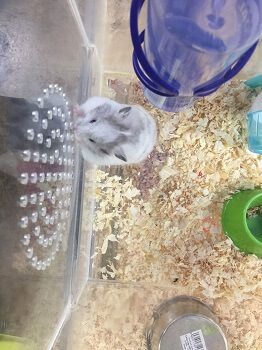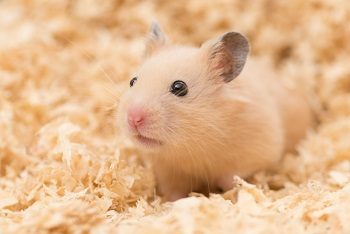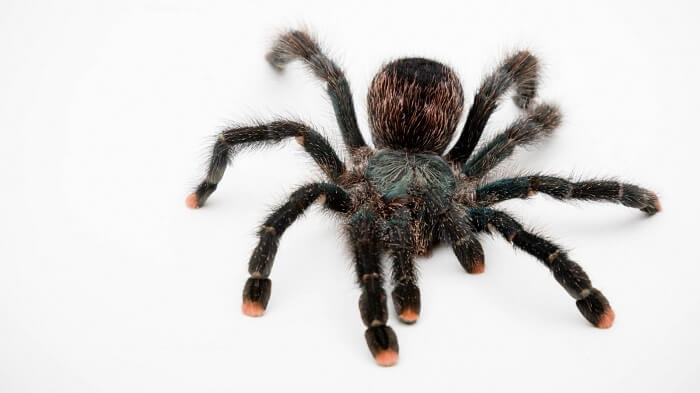Syrian Hamster – Mesocricetus auratus – is also referred to as “golden hamster” because of the golden-brown color it has in the wilderness. This color helps it to camouflage in the semi-desert regions, where he usually lives in. There are more than 40 different color variations from white to black; the name “golden hamster” is used only to name the original species.
Hamsters are the most common pets among rodents. This popularity is due to a number of reasons: They are undemanding, they take up little space and the price of a Hamster is low nowadays. The Syrian Hamster is a good pet and could be easy enough to be grown up and supervised by a child.
Origin and history of the Syrian Hamster
All Syrian Hamsters (Mesocricetus auratus) as pets come from a single gestation, being discovered in Syria in 1930. A traveling zoologist discovered the Syrian Hamster cubs and took three of them to Europe. In 1938, the first Syrian Hamsters were exported to the United States having as parents the three ones brought from Syria.
Initially, they were used as laboratory animals, but very quickly became popular as pets.
Every year, more than one million hamsters are used as laboratory animals, followed by mice and rats.
Physical description
The most famous Hamster is the Syrian Hamster, also known as the Syrian gold hamster or gold hamster. Its silk coat is a reddish-gold color and is close to its small and compact body. Syrian Hamster can have several different colors and fur lengths, ranging from albinos to full black.
External features of Syrian hamsters:
- Of all domestic hamsters, the Syrian is the largest.
- The length of the body may reach twenty centimeters in females. Males are always a little smaller.
- Their construction is thick, wide.
- The nose is round, with small clean ears and dark eyes.
- The number of toes on a Hamster’s feet is different. So, there are five fingers on the back legs, and there are four on the front legs. The fur of Syrians is either short or very long.
- Their color is very diverse and can be either monochromatic or stained.
- His tail is very small, discreet, and poorly covered with hair.
Syrians have perfume glands on each hip. Like other Syrian mammals, the scent of its glands is used as a means of marking the territory by rubbing it against vertical objects. In females, the second role of these glands is to signal the fertile (estuary) period by giving off a specific smell, attracting males. Occasionally these glands secrete an adhesive substance that is more visible in males.
Behavior and personality
Syrian Hamsters are night-time animals and are pretty quiet, except for the moments when they are surprised or disturbed from their 14-hour cycle of sleep during the day. If you wake up a Syrian Hamster during the day, while they are asleep, it is very possible that they will bite you. Most of the time, during the day, they are in their nest, sleeping, so you shouldn’t wake them up. Although the hamsters are thought to be small and lazy animals, they are in fact extremely active, especially during the night. In general, it is good to put it in a large cage, because they are very energetic and need a lot of space to run. The presence of a wheel in the cage/aquarium is also highly indicated.
 The Syrian Hamster generally lives alone in deep tunnels which are places with a lower temperature and higher humidity than the desert environment. They are solitary and extremely territorial animals, and that is why they can fight each other if in the same cage. Exceptions occur when we put together a female in a rut with a male, but even so, after they pair, the female will attack the male. Even brothers and sisters, who are mature, can attack each other.
The Syrian Hamster generally lives alone in deep tunnels which are places with a lower temperature and higher humidity than the desert environment. They are solitary and extremely territorial animals, and that is why they can fight each other if in the same cage. Exceptions occur when we put together a female in a rut with a male, but even so, after they pair, the female will attack the male. Even brothers and sisters, who are mature, can attack each other.
You might also like our article about owning a ferret.
Be careful when you let your hamster walk around the house. You can step on it, because the pet, sometimes, just runs through the house. It’s also known that if you leave the hamster out of the cage, it’s sure to crunch out something and damage things. Female hamsters have such bad habits. In nature, the females themselves take care of the family, therefore they are constantly trying to create an environment for the future family, while the males do not have the same instincts.
Taming a Syrian Hamster
They can be tamed if they are used to people since they are cubs. With patience, they can be taught to trust, to be taken into human hands, or to be pets.
Unlike dwarf hamsters, the Syrian are a little bit slower in their movements, so they can be held in strangers’ hands more easily if they are tamed.
Children will find them a little easier to hold and tame only with the condition that they must not force or disturb the hamsters, and that they must be very gentle while handling them.
Hamsters have memory and can remember if someone has harmed them. If this happens, the animal will no longer trust that individual.
To tame your pet in your hands, remove it from the cage as often as possible and play with it. If a person has little contact with the small hamster, and this happens usually when the hamsters are raised in large numbers, then it will be difficult to domesticate it. Most often, by the end of its life, it will dislike communication with the owner.
If your hamster doesn’t react well to your taming and keeps biting, do not lose patience and continue what you started. All the hamsters are born wild and become mild only with our help.
If you want to pet the Syrian hamster, remember that it has a weak sense of sight, but the smell is very developed. Your hands should therefore be clean and not smell like food.
Care and food
The food of the Syrian hamster should not consist only of seeds and cereal. It also enjoys most of the fresh vegetables, more than other hamster species.
The Syrian hamster’s stomach has two compartments that help digest hard food. In the first compartment, it ferments the food, being similar to that of the cows. Despite the complex digestive system, hamsters have to eat their own feces to complete digestion. This behavior is not unique, as Guinea pigs do the same.
The Syrian Hamster needs the following things: a lot of movement, fresh water and food, and a safe and quiet place to sleep during the day.
What does the Syrian hamster eat?
Hamsters should have a varied diet. Hamsters are omnivorous and often eat anything the owner gives them, even what it is really harmful to them: chips or cake crumbs. Bad food can really damage their overall health. Given the size of the pet, its liver and kidney will deteriorate in a few weeks. The diet should contain the following:
- Make sure you include fruits. Apples, pears, and quinces can be given to hamsters in any quantity.
- As for vegetables the pumpkin, carrot, and turnip are recommended.
- You can also give them fresh cucumbers, raw potatoes, cabbage, and beetroot, but in a low quantity.
- Your hamster should have wheat, maize, oats, and sunflower seeds in its daily diet.
- Small Hamsters like rolled oats.
- Give herbs to your pet in the summer. These can be dandelion leaves, bush, acacia flowers.
- One of the hamster’s favorite treats is green peas. You can give it in whole pods, which it will eat with pleasure.
- As it concerns the meat, minced meat should be offered to hamsters on an occasional basis. In nature, rodents eat beetles and caterpillars. It is not herbivore and requires animal protein too.
- Spoil your pet with cooked egg yolk in small and occasional amounts.
Syrian Hamsters should have a drinking vessel with clean water in the cage at room temperature. Females are also given milk during pregnancy.
Food waste must be removed from the cage\aquarium. You can often see how rodents fill their cheeks with food near the feeder and transfer them to another corner of the cage, where they place the food carefully. It is useless to fight with it because the instincts of a hamster cannot be defeated. So don’t stress and observe the fun behavior of your pet. Typically, hamsters store more than they can eat, so try to adjust the size of the diet yourself, so the pet does not carry food debris around the cage, forgetting about it.
Citrus fruit, egg white, soft bread, chocolate, bacon, any fat, and butter must be avoided.
What care conditions does the Syrian hamster need?
 The main thing to stress about when you own a Syrian Hamster is to clean its cage. The wet sawdust with food residues scattered should be carefully removed from the cage.
The main thing to stress about when you own a Syrian Hamster is to clean its cage. The wet sawdust with food residues scattered should be carefully removed from the cage.
Also, sometimes the cage needs to be washed. Despite the fact that the sawdust absorbs urine, it slowly flows onto the bottom of the cage.
Rinse the dishes with boiling water.
Hamsters are only bathed in extreme cases. This is usually done before selling animals to easily remove the smell.
Hamsters are clean, you can often see them cleaning their fur, but if you decide to bath it, use only warm water, then dry your pet with a hairdryer.
Protect the hamster’s ears while washing it and do not pour water and shampoo on its face. Remember, water treatments are stressful for hamsters.
Living conditions
The Syrian hamster is a solitary creature and needs only his own company. The Syrian Hamster cage should not be less than 30 centimeters long, but it would be very happy in a cage 60 centimeters long. It needs space to move, a thick layer of sawdust, and a quiet place to sleep all day long.
How to take care of a Syrian Hamster
To make your Syrian hamster feel comfortable, make sure you purchase a spacious cage for him. In addition, the hamster is a very active animal, so it will need a wheel to run so it can consume its energy. You will also need a feeder and sawdust. All of this is sold in a wide range in specialized stores, so you don’t have to worry about where or what type you should buy.
- Pour sawdust onto the bottom of the cage and place a food bowl in the corner. It is not recommended to replace sawdust with anything else. The sawdust absorbs the urine perfectly and neutralizes the smell in it. In addition, the animal will bury itself happily in scented sawdust and will feel comfortable and safe. Don’t take that pleasure away.
- Never use cotton wool or other unsuitable materials.
- Caring owners usually buy a lot of play accessories for their pets. In the middle of the cage, you can put a wooden block or ladder, on which the animal will exercise. If there is wood, then it will also serve as a material for tooth sanding.
- Pet stores can also offer you a house for hamsters, where they will hide while sleeping. In a word, the more toys in the spacious cage, the more fun the day will be for both the Hamster and its owner. After all, watching a funny animal will keep you entertained.
How long do Syrian hamsters live?
In the wilderness, the Syrian hamster barely reaches the age of two, but they’re real champions at home. Today, the record of life expectancy is seven years. So, how long your pet will live, will depend on you. An active life, a healthy diet, and a lack of stress are what it needs for a long and happy rodent life.
The health of the Syrian Hamster
The Rodent Health Organization advises you to determine the health of your pet by its weight. The hamster, if healthy, should weigh at least 150 grams. Sudden weight loss should alert you. It is recommended to weigh it at least once a week.
A sick animal can be identified by its fur; it becomes bored or its fat curls disappear if the hamster is long-hair.
You can know how ill is your Syrian hamster by taking it by the withers and lifting it up. If the animal extends its legs and does not tighten them, then things are bad.
The draught, as well as the sunlight falling directly onto the cage, are very damaging to the hamster. Place it away from the windows, and don’t place the cage on the floor either.
Reproduction
 If you do not intend to reproduce Syrian hamsters, then do not take a heterosexual pair, or cubs will not hesitate to appear. The female gives birth a lot; sometimes the number of cubs reaches twelve. The cubs are all pink when they are born, their hair appears gradually, as it grows. With the age, the number of born cubs decreases slightly.
If you do not intend to reproduce Syrian hamsters, then do not take a heterosexual pair, or cubs will not hesitate to appear. The female gives birth a lot; sometimes the number of cubs reaches twelve. The cubs are all pink when they are born, their hair appears gradually, as it grows. With the age, the number of born cubs decreases slightly.
Unfortunately, among these animals, there are frequent cases in which the mothers eat their children. What forces the mother to do so is not fully known. There are females who always eat their cubs, no matter what you do or the conditions you may offer. The cubs are fed with breast milk, but they quickly pass to adult food. In a month, hamsters become sexually mature and the reproduction period in a female hamster takes 18 months.
You cannot clean the cage where the mother is with her cubs for two weeks. The male should be removed from the cage a few days before the female gives birth. Food and fresh water should be added constantly with care to the female. The mother will be busy with its cubs at all times. Syrian hamster cubs scrape steadily, but over time they lose this capacity. An adult hamster can only be heard making noises during a fight with another hamster.
If there is no cage in which the female with the cubs can be moved, give the female crumpled paper so that it can hide in it. Keep in mind that after five weeks, the grown-up cubs will already fight for territory and they will also make their own cubs.
In captivity, cubs must be separated from their mother after 4 weeks, and can only be kept together for another 3 weeks, until they reach sexual maturity, and then they must be separated by sex. After the age of 8-10 weeks, it is recommended to house them in aquariums or separate cages, otherwise, they may cause serious injuries to one another.
Syrian hamsters, like all hamsters, are solitary and cannot live otherwise but alone. They are very territorial and they will fight other hamsters if they have to share the same cage. But this does not make them aggressive pets, but on the contrary, they are perhaps among the most popular species of hamsters that are kept as pets. They are active, entertaining and watching them is a real delight.




